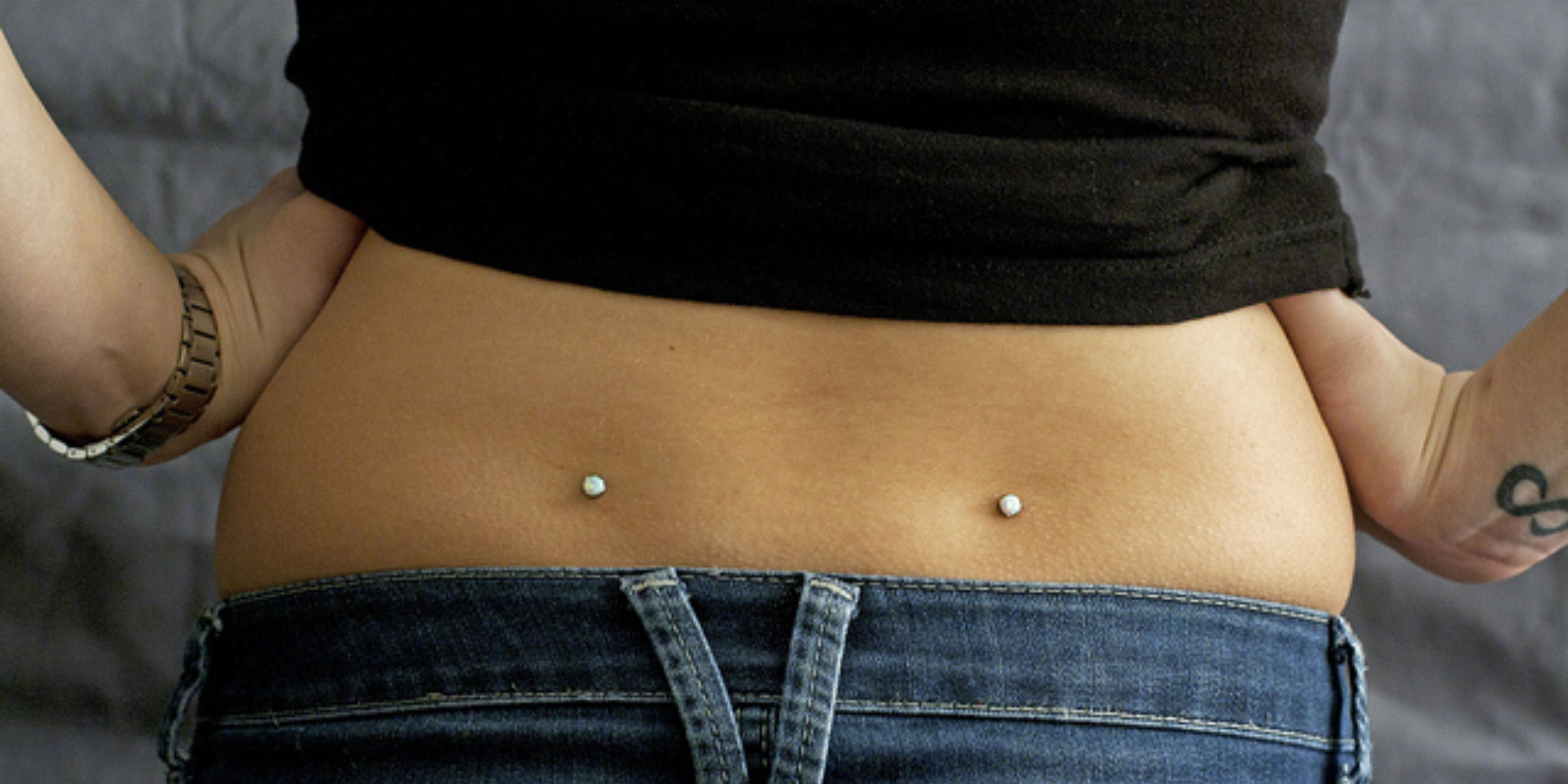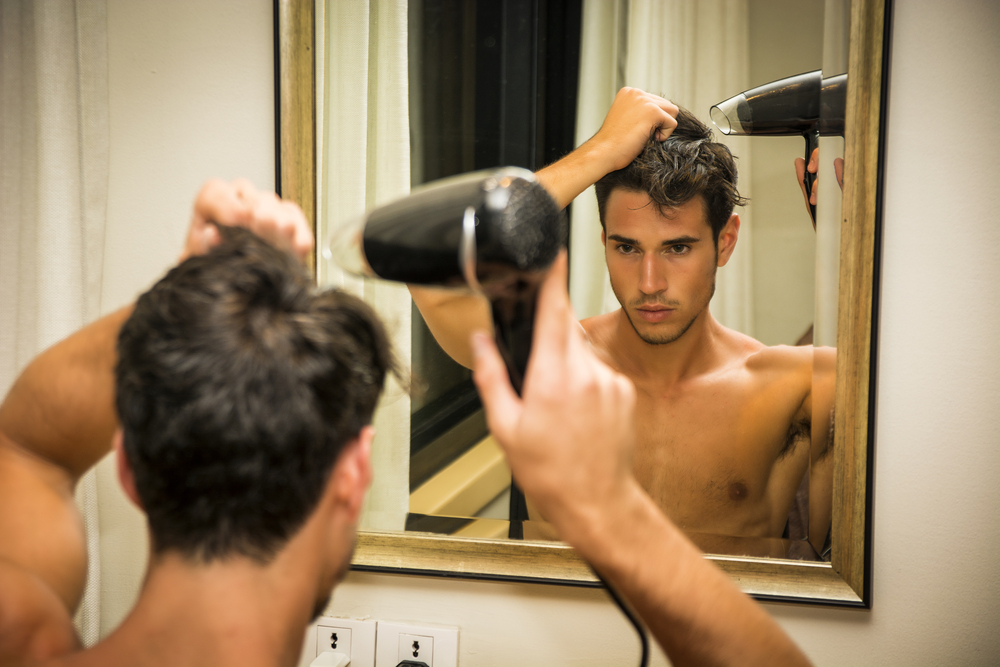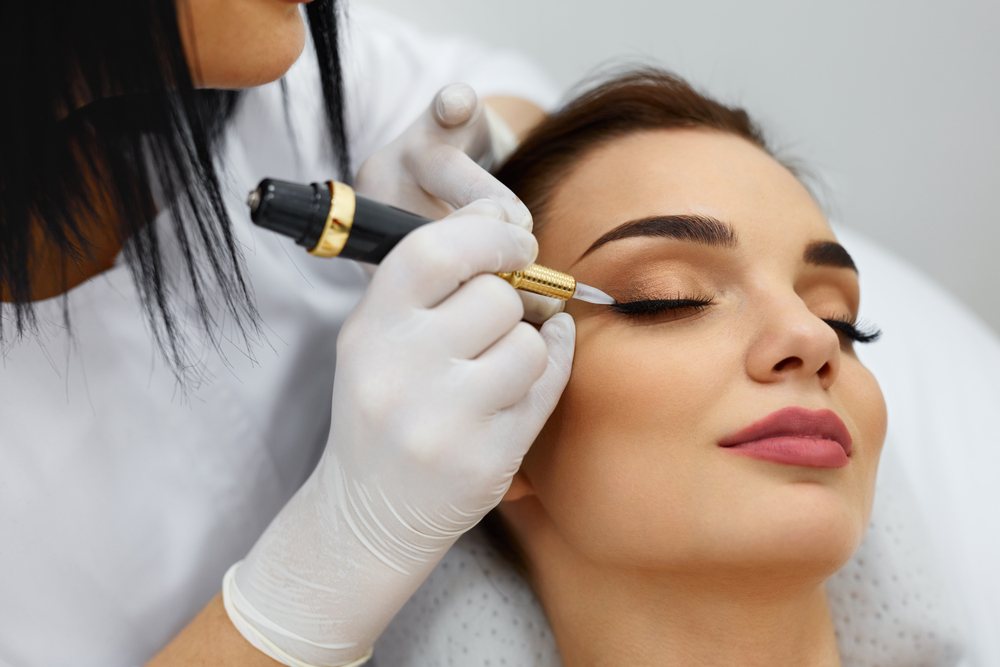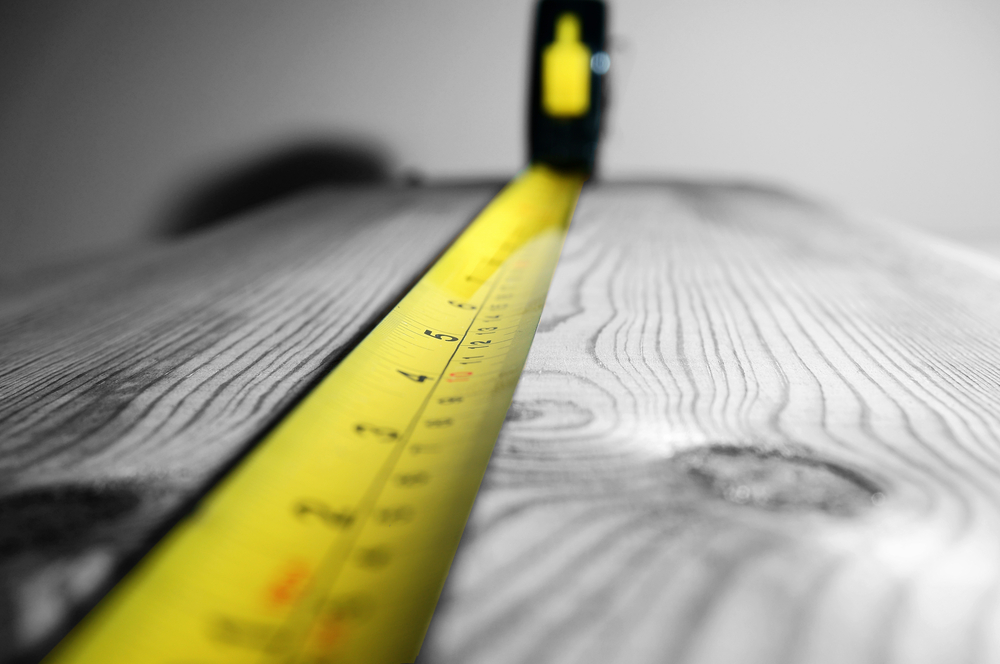Are you looking to bestow some extra flair to your back? If so, a back dimple piercing can be a unique and stylish way to enhance your body art. It is nothing but a dermal piercing with a small, single point that sits on the lower back, just above the waistline, giving the illusion of a natural dimple.
It’s becoming increasingly popular, and for a good reason! Not only is it a unique and eye-catching addition to your body art collection, but it’s also relatively easy to care for and can be done quickly.
We’ll look closer at back dimple piercings, including what to expect during the procedure, how to care for your new piercing, and more.
What Is Back Dimple Piercing?
A back dimple piercing is nothing but a dermal piercing placed above your butt and hip area in the dimples. These dermal piercings are aesthetically very appealing and tempting.
The back piercings are most widely seen in people with beautiful dimples or depressions on their back, i.e., on both sides at the end of their spine. These depressions are sometimes called “Venus Dimples” and the piercings “Venus Piercings.”
Back dimple piercings have been a trendsetter from ancient times and are still one. In the present era, having a piercing done on your back dimples is no more considered weird but a bolder statement towards beautifying your back.
Back Dimple Piercing – The Techniques
You can acquire the piercing in one of two ways based on your jewelry choice. Any piercer would typically have a preferred technique.
Technique #1: Clamp and Needle
If you choose to go with anchors, then the needle and clamp technique will be the preferred choice to pierce your back dimple. With the clamp in place, the professional will pierce the skin with the help of a needle to create an L-shaped pocket where the dermal will rest. The piercer will insert the anchor foot first while using forceps to hold the tiny incision wide open. The top of the anchor will have a screw top or a magnet that rests above the skin.
Technique #2: Skin Punch
A surgical punch is used to introduce a diver. The piercer will twist a surgical punch into your skin to draw off the section of flesh where the piercing will be located. The diver will be placed into the tiny hole created as a result.
Though both techniques are no superior to each other, the anchor offers some cosmetic versatility by allowing you to switch out your jewelry as you like, but it is different in the case of the diver. You can’t change the jewelry without taking out the diver.
Back Dimple Piercing – The Process
The process of piercing for back dimples varies since the piercing is done dermally and has no exit point. Here, single-point piercings are made on the surface of your back to anchor the ornament, unlike the traditional piercing process, where the piercing goes through from one side of the flesh and comes out from the other.
The process of back dimple piercing involves:
- Initially, your piercer will examine your back and the dimples to see if you are a good candidate for the back dimple piercing.
- If affirmed, the piercer will sterilize the skin of your back dimples with an anti-bacterial solution to prevent any transmission of bacterial infection post-procedure.
- The piercer will mark the spots on your back with the help of a body-piercing caliper for alignment and a skin-friendly marker.
- Depending on the type of jewelry you choose, your piercer will pierce the dimple with sterile tools with the relevant technique – a skin punch technique or a clamp-and-needle technique.
- After piercing the spot, the jewel will be force inserted into the pierced spot and anchored.
- The same process will be repeated on the other marked spot, i.e., your other back dimple.
- Both areas will be disinfected after the procedure as a final touch.
- The piercer will give you post-procedure instructions and tips to care for your back dimple ornaments.
Highly qualified piercers must perform dermal piercings since even a small mistake can damage the nerves or the blood vessels in the area pierced, which could become long-term suffering. Hence, choose an expert piercer with good hands-on experience in dermal piercing, particularly back dimple piercing.
Does Back Dimple Piercing Hurt?
Yes, it does. It isn’t fun thrusting something into your skin and flesh. Normally the pain differs from one individual to another; some may experience too much pain, and some experience much lesser pain, just like a tinge of an ant bite.
During the procedure, your piercer will either use a piercing needle or a dermal punch to remove a little portion of tissue beneath the skin and insert the dermal anchor. The intensity of the pain may vary depending on the chosen technique. Although using a dermal punch may seem more unpleasant than using a needle, most people report that it is actually much less uncomfortable. People hardly sense the skin being removed since the dermal punch is so sharp and moves swiftly – a technique strongly suggested by several piercers.
The back dimple area is sensitive compared to others. No matter what, the pain you feel largely depends upon your pain tolerance level, the method your piercer is using, and the experience your piercer has.
Back Dimple Piercing Jewelry
Consorting to the Association of Professional Piercers (APP), high-quality jewelry materials may lower the risk of allergic response or piercing rejection.
People with sensitive skin or nickel allergies may choose Titanium, Niobium, 14-karat gold, or implant-grade steel for the implants. These materials are hypoallergenic, don’t rust, and are suitable for dermal piercing.
Cost-wise, steel implants are affordable and suit the majority of people. On the contrary, if you have a nickel allergy, go for Gold, Titanium, or Niobium. For the most part, gold is safe as long as it isn’t gold-plated.
How Much Does The Back Dimple Piercing Cost?
Back dimple piercings cost you around $70 to $80 for each side, excluding the jewelry cost. The cost of the jewelry will start from $10 to $100 and more, depending on the material and style.
Other factors may also affect the cost of piercing, such as the geographical spot at your Venus, the physician or piercer you choose, the technique, the studio, and many more.
Risks Associated With Back Dimple Piercings
Getting your back dimples pierced may be generally safe if performed by an experienced professional piercer in a sterile environment. However, there are some potential risks consociated with dermal piercings that you must look out for.
- Infection: Any type of piercing can raise your risk of developing a skin infection. The chances may increase if the procedure is carried out improperly or if the piercing tools aren’t appropriately sterilized. For instance, unsterilized or contaminated tools or needles may transmit bacterial infections, including HIV and tetanus.
- Tissue Injury: The anchor may behave like a tiny wrecking ball and harm the tissues (including the blood vessels and veins) around it if it is inserted too deeply.
- Displacement: If the anchor isn’t placed deeply enough or the surface is overly roughened up, the anchor is away! Your tiny jewelry will either float to a new spot beneath your skin or fall off entirely.
- Rejection: You may run a risk of having your piercing rejected by your body. The rejection occurs because your immune system detects the metal as a foreign body and forces the jewelry out of your skin. The jewelry will hang or droop in such cases instead of sitting flat on the skin’s surface.
- Skin Tearing: The back dimple piercings are vulnerable because of their placement to snagging and tugging on clothing, towels, and bedding. Skin ripping may result from this. Even your jewels may come out if you’re not careful.
- Scarring: Some people tend to develop scars around the dermal piercings. Hypertrophic scars occur commonly, and fairly uncommon are the keloids. These can be treated with jojoba oil or silicone gel scar therapy to reduce the appearance of the scars.
- Allergic Reactions: Some people with sensitive skin or past allergic reactions may develop a skin reaction to the ornaments. In such cases, it is advisable to undergo a skin allergy test to prevent any complications post-piercing.
If you encounter any of the above, see your piercer or healthcare professional immediately to seek medical attention and avoid further complications.
Back Dimple Piercing – Healing Time And Aftercare
The piercings in the back dimples may take anywhere from 1 to 3 months. And for some people, it may go up to six months. Your overall health and how well you care for the piercing plays a major role in healing, and yes, of course, your piercer’s skill too.
You may notice crusting and swelling around the jewelry tops for at least one to two weeks, which will gradually improve as you heal.
During the healing period, you must follow the utmost care of the pierced spot. You must clean the pierced spot at least two to four times a day with saline water until it gets back to normal, and avoid any material contact with the pierced spot.
Ensure you wash your hands properly before touching the pierced spots. Maintain the pierced area clean and dry, and dab it dry with a paper towel if needed. Keep the spot covered with a band-aid for at least two days to prevent infections.
Wear loose-fitting clothes to avoid friction against the pierced area, and try to sleep on your side until it heals. Take showers to prevent harboring of bacteria and avoid activities that could irritate your back piercings.
In short, you have to be very cautious with your back piercings.
When Should You Meet The Doctor?
After 10 to 15 days post-piercing procedure, if you experience any unusual signs and symptoms, including:
- Fever
- Redness
- Swelling
- Itchiness
- Pus-like, yellowish or greenish discharge
- Continuous body aches
- Foul smell from the pierced sites
- Severe pain at the particular spot
You must visit your physician immediately for a prompt diagnosis and action.
Changing The Jewelry/Balls
You shouldn’t change the jewelry or balls until the piercing is completely healed. Visit your piercer to ensure adequate healing of the sites and to get your ornaments changed. Never change the balls by yourself since you may NOT BE ABLE to see your back piercings completely. It is extremely difficult to fix the jewelry on your own, and you may tamper with the dimple piercing on your back.
If you are an avid frequent changer of trends or want your back dimple jewelry out for whatever reason, visit your piercer, who will remove the top balls and the anchors/divers under your skin after performing a small incision. Your piercer will discuss the pros and cons as well as the tips to care for the same. You will have to wait for the hole to close, and you may develop a small scar in those areas during healing. It may fade away slowly but may/may not completely go away.
Things You Should Know Before Having A Back Dimple Piercing
The thought of having your back dimples pierced and flaunting it can be exciting, but consider the enlist before proceeding with the dermal piercing.
- You cannot wear all your favorite dresses for some time due to snagging, rubbing, and pulling the jewelry out. You must be cautious while choosing the outfits until the piercing is completely healed.
- Your sleeping positions will change, and you will be unable to sleep on your back for months after the piercing.
- Sitting postures will change, and you will feel discomfort when sitting for long hours.
- You cannot touch your back freely. Touching your back or around the pierced area may irritate you. You have to be careful while taking showers not to touch your back. Remember, feeling your back consciously or unconsciously may cause you immense discomfort.
- You must frequently visit the studio to ensure the pierced site is not infected and has healed well.
- You must restrict physical and other contact activities that could impact your back.
Apart from the ones mentioned, you must be very cautious about everything you do post-piercing for proper healing and not to hurt your back at any cost.
The Stopping Point
Piercing your back dimples can be exciting, and pairing them with tattoos and crop tops with low waist outfits may add a flair to your back. But remember, it’s important to consider the risks and healing time before getting one. Proper aftercare is also crucial to ensure a successful healing process.
With proper care, your new dimple piercing will heal quickly and look great for years. If you’re considering a back dimple piercing, be sure to do your research, consult a professional piercer, and take care of your piercing properly to ensure a safe and successful healing process.









